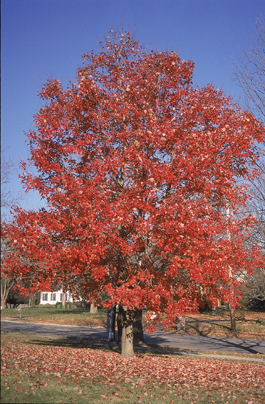
If you’re in the market for a tree, consider a maple. Japanese maples are probably the best-known members of the family, but we’re inviting you to meet other types of maple trees. May be affected by scale insects, aphids, and verticillium wilt. From broad and spreading Norway maples, to columnar red maples, to short and shrubby Emerald Elf’ amur maple, you can find a maple tree to fit any planting need.Plant in an area where grass below it will not need to be mowed, so the roots will not be damaged by the mower. Roots are often shallow and reach the surface at an early age.Fertilize in spring before the leaves emerge. If pruning is necessary, prune during the dormant season and avoid pruning in spring when the sap is running. Low maintenance, this tree needs little pruning.Sugar maple is susceptible to salt, excessive heat, and leaf scorch in drought. It does not grow well on dry, shallow soils and is rarely if ever, found in swamps. Sugar Maple grows on sands, loamy sands, sandy loams, loams, and silt loams, but it does best on well-drained loams.
#TYPES OF MAPLE TREES IN PENNSYLVANIA FULL#
#TYPES OF MAPLE TREES IN PENNSYLVANIA HOW TO#
Native Americans taught the early colonists how to tap these trees to produce maple syrup.

The mixed mesophytic forests, which reach their greatest development in the Smoky Mountains, just reach southern Pennsylvania. The sugar maple leaf is the national symbol of Canada. The Great Lakes beech-sugar maple forest is represented at the western end of the state. It typically grows as a large shrub or small tree to 15-25’ tall (less frequently to 40’ tall) with a rounded but uneven.

Long-lived and slow-growing, Sugar Maple also provides some winter interest, with its attractive, gray-brown bark, often ridged and furrowed with age. Acer pensylvanicum commonly known as snakebark maple is a shrubby understory maple that is native to moist, rocky forests from Wisconsin to Quebec and south in the Appalachians to Georgia. In spring, greenish-yellow flowers, borne in short, upright sprays appear before the leaves and are followed by two-winged samara. (7-15 cm) ranges from medium to dark green in summer, and changes to a brilliant palette of yellows, oranges, and reds in the fall. Its foliage of five-lobed leaves, 3-6 in. To determine the plant hardiness zone for your area, click on the state of Pennsylvania. Noted for its spectacular fall color, Acer saccharum (Sugar Maple) is a large, deciduous tree with a straight trunk, wide-spreading branches, and a dense, oval to rounded crown.


 0 kommentar(er)
0 kommentar(er)
